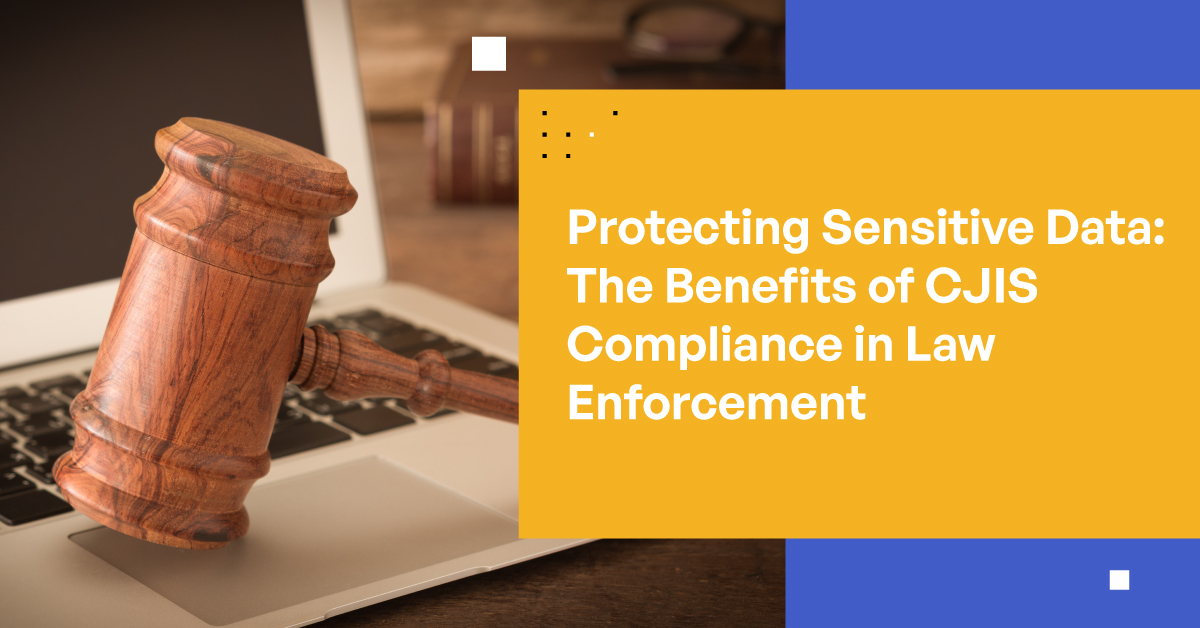Protecting Sensitive Data: The Benefits of CJIS Compliance in Law Enforcement
In 1992, the FBI established Criminal Justice Information Services (CJIS), which has now become the bureau’s largest division. It is comprised of numerous departments, including the National Crime Information Center (NCIC), Integrated Automated Fingerprint Identification System (IAFIS), and the National Instant Criminal Background Check System (NICS). Through the use of analytics and statistics provided by law enforcement, CJIS monitors criminal activities in local and international communities. Moreover, their databases serve as a centralized source of criminal justice information (CJI) to agencies throughout the country.

Since 1992, significant changes have occurred worldwide, particularly in the realm of technology. The widespread usage of the internet and cloud computing, combined with the escalating rate and complexity of cybersecurity threats, has significantly complicated the process of safeguarding CJIS private data.
Consequently, CJIS has established a comprehensive set of security standards for organizations, cloud vendors, local agencies, and corporate networks to help ensure that this information is kept safe. The FBI created the Criminal Justice Information Services (CJIS) Security Policy, which outlines a set of security requirements that all organizations handling this information must follow. This dictates that organizations have a detailed cybersecurity risk management strategy in place. This article takes a closer look at CJIS compliance, including its requirements and benefits.
What Is CJIS Compliance?
CJIS compliance refers to the set of security standards that all organizations handling criminal justice information must adhere to. These standards are designed to ensure the confidentiality, integrity, and availability of this private information. CJIS is to law enforcement agencies what the National Institute of Standards & Technology (NIST) is to federal agencies.
It covers a range of areas, including access control, audit and accountability, and incident response. By enforcing these stringent security measures, CJIS can ensure the protection of sensitive data, such as criminal records and other CJI, from cyberattacks. This is critical, as the CJIS databases are vital tools for law enforcement to combat crime and keep communities safe.
In order to comply with CJIS, organizations must first obtain a signed and approved CJIS Security Policy from the CJIS Division. This policy states that access to any criminal justice information must be restricted to only authorized personnel and must be protected by a secure system.
Who MUST Comply With CJIS?
According to the FBI, the primary objective of the CJIS Security Policy is to establish necessary controls that ensure the safeguarding of CJI throughout its life cycle, whether it is at rest or in transit. The policy offers comprehensive guidelines for creating, viewing, modifying, transmitting, disseminating, storing, and destroying CJI. It applies to all individuals, regardless of their association with criminal justice services and information. This includes contractors, private entities, non-criminal justice agency representatives, and members of criminal justice entities, who have access to or operate in support of such services and information. By adhering to the CJIS Security Policy, these individuals can play a significant role in maintaining the confidentiality, integrity, and availability of CJI.
Why Is CJIS Compliance Important?
The CJIS Security Policy incorporates directives from various sources, including presidential directives such as Executive Order 14028, federal laws, FBI directives, and the criminal justice community’s APB decisions. Additionally, it incorporates nationally recognized guidance from the National Institute of Standards and Technology. By consolidating these sources of guidance, the CJIS Security Policy provides a well-rounded and robust framework for protecting CJI. It helps ensure the protection of sensitive data and fosters a secure and trustworthy environment for criminal justice services and information.
Requirements of CJIS Security Policy
The CJIS Security Policy outlines various requirements that organizations must follow to ensure the security of CJI. Some of the most critical requirements include:
Personnel Security
Organizations must conduct thorough background checks on personnel who have access to CJI. They should also provide security awareness training to ensure that employees understand their security responsibilities.
Physical Security
Organizations must implement physical security controls, such as access controls, video surveillance, and intrusion detection systems, to protect the physical infrastructure that houses CJI.
Access Controls
Organizations must implement access controls that limit access to CJI based on job function and need-to-know. They should also enforce strong password policies, two-factor authentication, and session timeouts.
Audit and Accountability
Organizations must implement audit and accountability controls that enable them to monitor and track access to CJI. They should also retain audit logs for a specified period and review them regularly to detect unauthorized access or suspicious activities.
Incident Response
Organizations must establish an incident response plan that outlines the steps to take in case of a security breach. The plan should include procedures for reporting the incident, notifying affected parties, and conducting an investigation.
Best Practices for CJIS Security Policy Compliance
Complying with the CJIS Security Policy can be a complex and challenging process. However, by following best practices, organizations can streamline the compliance process and ensure that they meet the policy’s requirements. Some of the best practices for CJIS Security Policy compliance include:
- Conduct a Risk Assessment: Organizations should conduct a thorough risk assessment to identify potential threats and vulnerabilities to their information systems. The assessment should include an evaluation of physical security, access controls, network security, and incident response procedures.
- Implement Technical Controls: Organizations should implement technical controls, such as firewalls, intrusion detection systems, and encryption, to protect CJI from unauthorized access.
- Develop Security Policies and Procedures: Organizations should develop comprehensive security policies and procedures that address all aspects of information security. The policies should be regularly reviewed and updated to ensure they remain effective.
- Provide Security Awareness Training: Organizations should provide security awareness training to all employees who have access to CJI. The training should cover the risks associated with mishandling CJI, the importance of data privacy, and best practices for protecting sensitive information.
- Monitor and Review Compliance: Organizations should regularly monitor and review their compliance with the CJIS Security Policy. They should conduct periodic assessments, audits, and penetration testing to identify vulnerabilities and ensure they are meeting the policy’s requirements.
Benefits of CJIS Compliance
Ensuring CJIS compliance has numerous benefits for organizations handling criminal justice information. Some of the key benefits include:
Enhanced Security
One of the most significant benefits is increased security. By implementing the necessary security measures, agencies can ensure the protection of criminal justice information, thereby reducing the risk of data breaches and cyberattacks.
Compliance With Regulations
CJIS compliance is required for organizations that handle criminal justice information. By complying with these regulations, organizations can avoid legal and financial penalties.
Increased Trust
Achieving CJIS compliance also helps agencies to build trust with the public. The public expects the government to protect their sensitive data, and achieving CJIS compliance demonstrates a commitment to protecting that data.
Consequences of Noncompliance With CJIS
The CJIS Security Policy is essential for maintaining the integrity of the criminal justice system. CJI contains sensitive data that, if mishandled or disclosed, could compromise ongoing investigations, reveal the identities of confidential informants, or harm public safety.
Failure to comply with the CJIS Security Policy can result in severe consequences, including suspension or revocation of access to CJI, civil and criminal penalties, and damage to an organization’s reputation. Thus, it is crucial for organizations to adhere to the policy’s standards and requirements.
How Kiteworks Private Content Network Helps Organizations Achieve CJIS Compliance
The Kiteworks Private Content Network enables law enforcement agencies to achieve CJIS compliance through content-based zero trust that employs unified sensitive content communications and tracking and control of file and email data into one platform. The Kiteworks hardened virtual appliance enables the Private Content Network to protect sensitive content communications using security layering, such as end-to-end encryption, multi-factor authentication, an embedded antivirus, firewall, and WAF capabilities, artificial intelligence (AI)-enabled content anomaly detection, an intrusion detection system, and other security capabilities. It also uses double encryption at the file and volume levels. ensuring that your data is secure both in transit and at rest. Finally, Kiteworks enables law enforcement agencies to control access to their data and to monitor all user activity to the level of who can view and edit content, to whom it can be shared and sent, from which devices, and more. Using audit logs, law enforcement agencies can generate detailed reports to demonstrate CJIS compliance.
The Kiteworks platform demonstrates CJIS compliance in all applicable policy areas, including:
Policy Area 4: Auditing and Accountability
Full auditing and accountability through reports accessible through Admin dashboards, as well as through audit log and SNMP. Administrators can comply with legal requests to preserve and collect all relevant files and metadata and to set content retention policies to meet CJIS compliance requirements.
Policy Area 5: Access Control
Kiteworks delivers access control through LDAP, SSO, 2FA, and local databases for external user authentication. It also provides granular permissions for individual folders for collaboration.
Policy Area 6: Identification and Authentication
Kiteworks provides authentication through LDAP, SSO, and 2FA. Whatever combination of these best-practice authentication measures is applied helps with CJIS compliance.
Policy Area 7: Configuration Management
Kiteworks enables full administrative control over configuration management. Here, the Kiteworks platform also provides access restrictions for changes.
Policy Area 10: System and Communications Protection and Information Integrity
Kiteworks provides end-to-end encryption of data in transit and data at rest using AES-256 and TLS 1.2 encryption. The Kiteworks platform is also available in FIPS 140-2 certified and compliant configurations. More importantly, customers also retain sole ownership and control of their encryption keys.
Policy Area 13: Mobile Devices
Kiteworks includes major mobile operating systems support. Native mobile device management (MDM)-light capabilities such as remote data wipe, secure encrypted containers, access PINs, token lifetime configuration, and mobile app whitelisting are all available through the Kiteworks platform. Using the Kiteworks mobile app, which is available in the Apple and Google stores without charge, users can create, edit, share, send, and collaborate on files on their iOS and Android mobile devices.
Government and law enforcement agencies such as the City of Pleasanton, Abbotsford Police Department, South Carolina Attorney General’s Office, Texas Juvenile Justice Department, and the County of Sacramento, among others, rely on Kiteworks to unify, control, track, and secure their sensitive content communications while ensuring and demonstrating compliance with CJIS.
To learn more about the Kiteworks Private Content Network and how it helps law enforcement agencies to demonstrate CJIS compliance, schedule a custom demo today.

